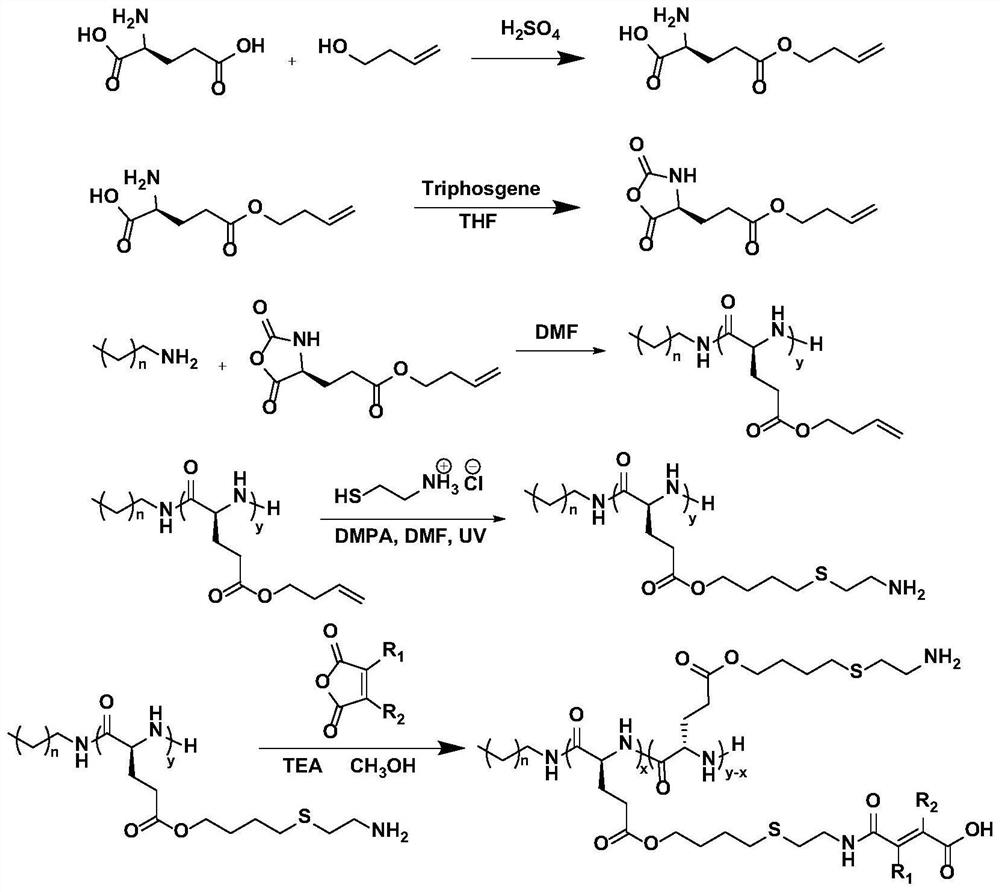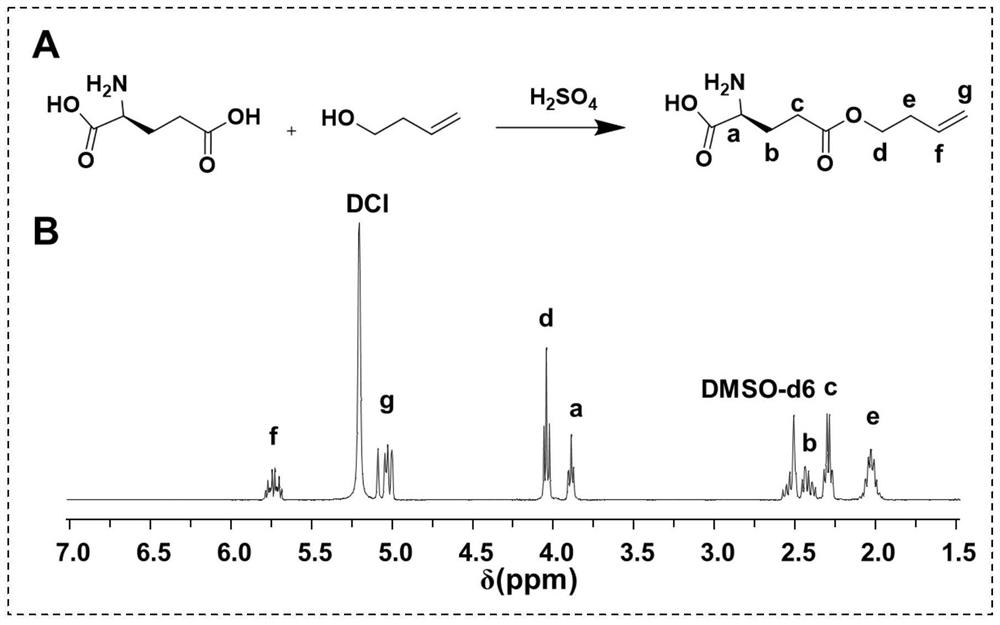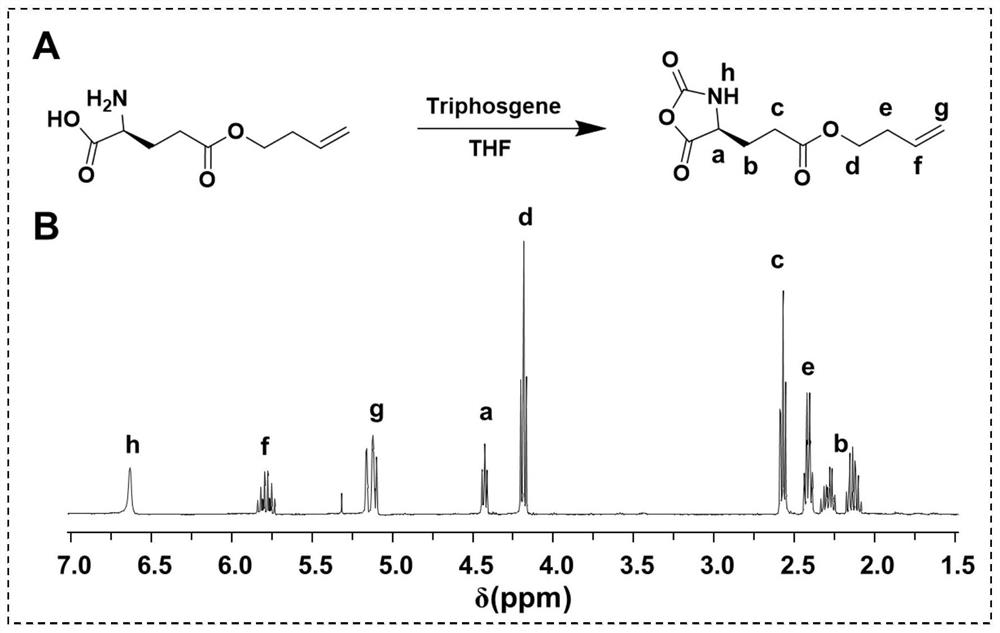A ph-responsive non-helix-helix transition antimicrobial polypeptide and preparation method thereof
A non-helix and helical technology, applied in the field of non-helix-helix transformation antibacterial polypeptide materials and their preparation, can solve the problems of difficult to achieve precise control, low pH response sensitivity, complex synthesis process, etc., to reduce toxicity and improve antibacterial effect. , the effect of reducing hemolytic activity
- Summary
- Abstract
- Description
- Claims
- Application Information
AI Technical Summary
Problems solved by technology
Method used
Image
Examples
Embodiment 1
[0074] A pH-responsive non-helix-helix transition antimicrobial polypeptide route such as figure 1 , the specific method is as follows:
[0075] 1) Preparation of glutamic acid derivative ButLG
[0076] Take 10g of glutamic acid in a 250mL round-bottomed flask, add 15mL of anhydrous 3-buten-1-ol, place the round-bottomed flask in an ice-water bath, add 4mL of concentrated sulfuric acid under stirring conditions, remove the ice-water bath, and stir React for 12 hours until the reaction solution becomes colorless and transparent; adjust the pH of the reaction solution to 7.0 with saturated sodium carbonate, remove the liquid by suction filtration, wash twice with deionized water to remove inorganic salts; transfer the white solid to a 250 mL circular Add 4mL isopropanol and 4mL deionized water to the bottom flask, heat to 80°C with an oil bath and stir until completely dissolved and become colorless and transparent. Stop stirring and cool down to room temperature; remove the li...
Embodiment 2
[0092] Secondary Structure Regulation of a pH-Responsive Non-Helix-Helix Transition Antimicrobial Polypeptide
[0093] 1) The charge of the side chain of the polypeptide affects the helical structure of the polypeptide
[0094] By introducing different numbers of maleic anhydride modifications into the side chain of the polypeptide PButLG-CA, circular dichroism was measured to explore the influence of the number of negative charges introduced by the side chain on the secondary structure of the polypeptide, such as Figure 7 X in Part A of X represents the amount of maleic anhydride modified by the side chain, and the helical structure is the weakest when the side chain is modified with 5 maleic anhydrides. Figure 7 It is more intuitively reflected by the calculation of helicity in part B of , when the side chain introduces half of the heterogeneous charge, the helicity is the lowest.
[0095] 2) Synthesis of unresponsive non-helical polypeptide PButLG-MA
[0096] Weigh 1.0g...
Embodiment 3
[0101] Antibacterial activity and hemolytic toxicity of pH-responsive non-helical-helical transition antimicrobial peptides
[0102] 1) Hemolysis test:
[0103] Take an appropriate amount of sheep whole blood in a centrifuge tube, dilute it with 1×PBS, and prepare a 4% (v / v) sheep blood solution; use PBS to prepare a series of drug solutions, add 100 μL / tube to the EP tube, and then add Equal volume of 4% sheep blood; PBS and equal volume of 4% sheep blood were mixed as a negative control group; 0.1% Triton and equal volume of 4% sheep blood were mixed as a positive control group; samples were mixed and placed in Incubate at 37°C for 60min. Subsequently, the sample was placed at 4°C for centrifugation (1000rpm / 5min); after centrifugation, 100 μL of the supernatant was taken into a 96-well plate, and the absorbance was measured at 576nm to calculate the hemolysis rate. The calculation formula is as follows: hemolysis=(OD 实验组 -OD 阴性组 )÷(OD 阳性组 -OD 阴性组 )×100%. Such as Fi...
PUM
 Login to View More
Login to View More Abstract
Description
Claims
Application Information
 Login to View More
Login to View More - R&D
- Intellectual Property
- Life Sciences
- Materials
- Tech Scout
- Unparalleled Data Quality
- Higher Quality Content
- 60% Fewer Hallucinations
Browse by: Latest US Patents, China's latest patents, Technical Efficacy Thesaurus, Application Domain, Technology Topic, Popular Technical Reports.
© 2025 PatSnap. All rights reserved.Legal|Privacy policy|Modern Slavery Act Transparency Statement|Sitemap|About US| Contact US: help@patsnap.com



